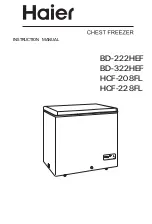
UF V (E2+E2.1) 03/2013
page 74/112
WARNING
High concentration of CO
2
(> 4 vol.-%).
Risk of death by suffocation.
Danger of poisoning.
Operate the CO
2
emergency cooling only in a well-ventilated room.
Ensure technical ventilation measures. Install a suitable conduct at the CO
2
discharge
outlet of the emergency cooling system.
Observe the relevant regulations for handling CO
2
.
We recommend connecting an exhaust hose to the CO
2
discharge outlet (14) and to conduct it to the
outside or to an exhaust system. Since the CO
2
emergency cooling system is also effective in case of a
power failure, an uninterruptible power supply is recommended for the exhaust system.
The controller RP1 measures and controls the temperature value inside the useable volume. Depending
on the increase or decrease of temperature, the controller RP1 controls the CO
2
emergency cooling in
standard operation and during power failure. As soon as the preselected emergency cooling temperature
is reached inside the useable volume, the solenoid valve of the emergency cooling system opens, and
liquid CO
2
from the CO
2
pressure cylinder is injected at intervals into the useable volume. The liquid CO
2
expands until ambient pressure and evaporated into the useable volume. This results in cooling-down the
useable volume to the pre-set emergency cooling temperature.
When opening the outer door, CO
2
injection is interrupted. This prevents potential cold burns / frostbite by
inflowing CO
2
gas at manipulation inside the freezer.
After turning on the freezer, the CO
2
emergency cooling is inactivated for 60 minutes. Only after this time,
the CO
2
emergency cooling – when switched on – is activated.
To prevent activating the CO
2
emergency cooling at too high temperature after turning on the
unit, release in the menu in the menu “OP.U” (Operating Mode USER) should take place only
after reaching the temperature set-point for the first time.
When operating the CO
2
emergency cooling, the temperature distribution may deviate from the technical
data valid at -80 °C (chap. 18.4).
Activating the CO
2
emergency cooling
1. Open the valve of the CO
2
gas cylinder
2. Release the CO
2
emergency cooling at the controller: Set the parameter “
En.E
” in the menu “OP.U”
(Operating Mode USER, chap. 8.3) to “On” and confirm with “MODE”.
2. Select the emergency cooling temperature at the controller: Set the parameter “
SP.E
” in the menu
“OP.U” (Operating Mode USER, chap. 8.3) to the desired value (range -40 °C up to -70 °C) and con-
firm with “MODE”.
Test run
Activate an emergency cooling test run at the controller: Set the parameter “
tS.E
” in the menu “OP.U”
(Operating Mode USER, chap. 8.3) to “On” and confirm with “MODE”. The emergency cooling turns on
for 10 seconds. The parameter “
tS.E
” then automatically rests to “OFF”.
Inactivating the CO
2
emergency cooling
1. Inactivate the CO
2
emergency cooling at the controller: Set the parameter “
En.E
” in the menu “OP.U”
(Operating Mode USER, chap. 8.3) to “OFF” and confirm with “MODE”.
2. Close the valve of the CO
2
gas cylinder.
Note: When activating or deactivating the CO
2
emergency cooling you need to restart the
controller. Turn off the main switch (key switch) for 10 seconds and then turn it on again.
Summary of Contents for 9020-0213
Page 6: ...UF V E2 E2 1 03 2013 page 6 112...
Page 7: ...UF V E2 E2 1 03 2013 page 7 112 Product registration...
Page 104: ...UF V E2 E2 1 03 2013 page 104 112 18 7 Dimensions UF V 500 E2 xxx Indications in mm...
Page 105: ...UF V E2 E2 1 03 2013 page 105 112 18 8 Dimensions UF V 500 E2 1 xxx Indications in mm...
Page 106: ...UF V E2 E2 1 03 2013 page 106 112 18 9 Dimensions UF V 700 E2 1 xxx Indications in mm...
Page 113: ......
















































